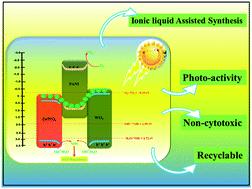当前位置:
X-MOL 学术
›
Environ. Sci.: Nano
›
论文详情
Our official English website, www.x-mol.net, welcomes your
feedback! (Note: you will need to create a separate account there.)
Ionic liquid-assisted synthesis of a novel PANI/ZnWO4/WO3 ternary nanocomposite: a facile double electron transfer photocatalyst for efficient degradation of a herbicide
Environmental Science: Nano ( IF 5.8 ) Pub Date : 2021-08-13 , DOI: 10.1039/d1en00563d Bapun Barik 1, 2, 3, 4 , Monalisa Mishra 2, 3, 4, 5 , Priyabrat Dash 1, 2, 3, 4
Environmental Science: Nano ( IF 5.8 ) Pub Date : 2021-08-13 , DOI: 10.1039/d1en00563d Bapun Barik 1, 2, 3, 4 , Monalisa Mishra 2, 3, 4, 5 , Priyabrat Dash 1, 2, 3, 4
Affiliation

|
This study reports a novel, efficient, and non-toxic polyaniline–ZnWO4–WO3 (PZW) ternary nanocomposite, synthesized following an ionic liquid (IL)-assisted in situ oxidative polymerization method. The as-prepared nanocomposite was utilized towards improved photocatalytic wastewater treatment and toxicity removal. Initially, individual ZnWO4 and WO3 nanostructures were synthesized using an IL-assisted solvothermal method. Thereafter, the subsequent modification of the ZnWO4 and WO3 nanostructures with the polyaniline (PANI) conducting polymer was done by in situ oxidative polymerization of PANI. Comprehensive analysis of the structural and morphological properties of the nanocomposite revealed high structural integrity and close contact between the individual components. The optical and photo-electrochemical investigations suggested rapid charge carrier separation, suitable band arrangement, and a superior lifetime of the nanocomposite. Afterward, the recyclable ternary nanocomposite demonstrated a higher solar light-mediated photocatalytic degradation of the toxic glyphosate (GLP) herbicide (Kapp = 0.0707 min−1). Additionally, the non-toxic nature of the nanocomposite (after a catalytic cycle) and treated GLP solutions were assessed via the standard TBE (trypan blue dye exclusion) assay. Furthermore, the XPS analysis, radical trapping experiment, and reactive oxygen species quantification (HO˙ and O2˙−) study suggested a possible double electron transfer type Z-scheme mechanism, which accounts for superior solar light-assisted N–C bond cleavage of GLP herbicide.
中文翻译:

离子液体辅助合成新型 PANI/ZnWO4/WO3 三元纳米复合材料:一种用于有效降解除草剂的简便双电子转移光催化剂
本研究报告了一种新型、高效且无毒的聚苯胺-ZnWO 4 -WO 3 (PZW) 三元纳米复合材料,该复合材料采用离子液体 (IL) 辅助的原位氧化聚合方法合成。所制备的纳米复合材料用于改进光催化废水处理和毒性去除。最初,单独的 ZnWO 4和 WO 3纳米结构是使用 IL 辅助的溶剂热法合成的。此后,ZnWO 4和WO 3纳米结构与聚苯胺(PANI)导电聚合物的后续改性是通过原位完成的PANI的氧化聚合。对纳米复合材料的结构和形态特性的综合分析表明,单个组分之间具有高度的结构完整性和紧密接触。光学和光电化学研究表明,该纳米复合材料具有快速的电荷载流子分离、合适的能带排列和优异的寿命。之后,可回收的三元纳米复合材料表现出更高的太阳光介导的光催化降解有毒草甘膦(GLP)除草剂(K app = 0.0707 min -1)。此外,纳米复合材料(催化循环后)和处理过的 GLP 溶液的无毒性质通过标准 TBE(台盼蓝染料排除)测定。此外,XPS 分析、自由基捕获实验和活性氧物质量化(H2O˙ 和 O 2 ˙ -)研究表明可能存在双电子转移型 Z 型机制,这解释了优越的太阳光辅助 N-C 键裂解GLP 除草剂。
更新日期:2021-08-15
中文翻译:

离子液体辅助合成新型 PANI/ZnWO4/WO3 三元纳米复合材料:一种用于有效降解除草剂的简便双电子转移光催化剂
本研究报告了一种新型、高效且无毒的聚苯胺-ZnWO 4 -WO 3 (PZW) 三元纳米复合材料,该复合材料采用离子液体 (IL) 辅助的原位氧化聚合方法合成。所制备的纳米复合材料用于改进光催化废水处理和毒性去除。最初,单独的 ZnWO 4和 WO 3纳米结构是使用 IL 辅助的溶剂热法合成的。此后,ZnWO 4和WO 3纳米结构与聚苯胺(PANI)导电聚合物的后续改性是通过原位完成的PANI的氧化聚合。对纳米复合材料的结构和形态特性的综合分析表明,单个组分之间具有高度的结构完整性和紧密接触。光学和光电化学研究表明,该纳米复合材料具有快速的电荷载流子分离、合适的能带排列和优异的寿命。之后,可回收的三元纳米复合材料表现出更高的太阳光介导的光催化降解有毒草甘膦(GLP)除草剂(K app = 0.0707 min -1)。此外,纳米复合材料(催化循环后)和处理过的 GLP 溶液的无毒性质通过标准 TBE(台盼蓝染料排除)测定。此外,XPS 分析、自由基捕获实验和活性氧物质量化(H2O˙ 和 O 2 ˙ -)研究表明可能存在双电子转移型 Z 型机制,这解释了优越的太阳光辅助 N-C 键裂解GLP 除草剂。











































 京公网安备 11010802027423号
京公网安备 11010802027423号